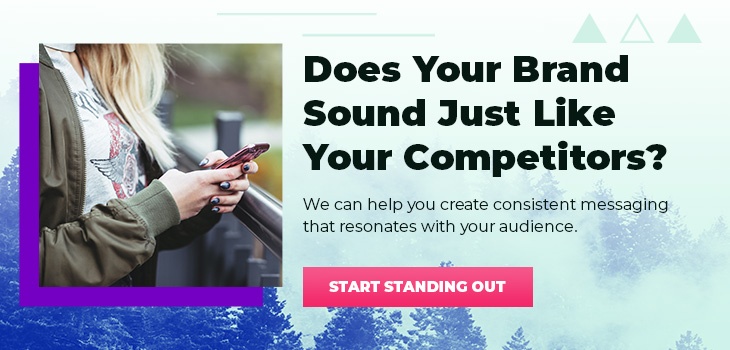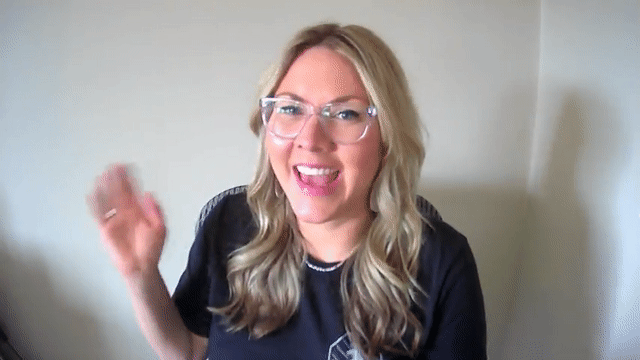Blog topics are tricky. When you started searching for them, you probably assumed it would be easy to pick a handful from the bountiful tree that is content topics in your industry. But then you look up and realize you aren’t standing in front of just one tree. You’re actually in an orchard. A big one.
What most marketing professionals struggle with isn’t necessarily finding topics, it’s choosing effective ones. You have to parse through all your options and pick out the handful of areas that do two things: bring value to your readers and position your brand as an authority.
Lucky for you, this is one of the few areas where “easier said than done” doesn’t really apply. You just have to set up a process that gives you the information you need to choose a direction and the tools to create a strategy focused on that space. You can do this in three steps:
- Define your audience and what they want
- Evaluate your competition
- Create a content strategy
Define Your Audience and What They Want
Effective blog content directly addresses your target audience’s questions, which typically pop up as they progress toward purchasing your product or service. Sometimes potential customers know exactly what information they need and how to ask for it. Other times they might realize they need something from you, but don’t quite know what questions to ask.
In both cases, you have to provide relevant, valuable content that educates your audience and makes them more comfortable entering your sales funnel. To find topics that can achieve both of these objectives, you need to understand the buyer’s journey and the customer’s relationship with your brand.
Map Out the Buyer’s Journey
It’s important to target customer journey stages with information that keeps potential customers moving forward in your sales funnel. Figuring out what information they need to do this is often just finding the answer to some simple questions:
- What objections do customers have in each stage?
- What criteria are they using to compare you to other services and products?
- What do they need your service for? Business or personal?
- If business, do they have specific directives from their manager or supervisor regarding features, budget, etc.?
It’s usually most helpful to start by defining the problem your buyer is facing in their current buyer’s journey stage. For example, someone who just learned they need to regularly clean their air ducts will need different information than someone who’s ready to sign up with a service that handles that chore for them. When you target the topics that match your customers’ buyer journey stage, you give them the precise information they need to take the next step with your brand.
Assess Their Relationship with Your Brand
As you start to understand how the buyer’s journey affects the questions people ask, you should also track how familiar people are with your brand, product or service. Are you in a niche industry or one widely known? For example, all Nike customers know what the brand has to offer. But they might not know about their hometown shoe manufacturer.
Large brands have the benefit of brand awareness, which means they don’t have to introduce themselves before showcasing their products to customers. It’s important to understand your influence in the market and the awareness around your solution. This will greatly impact which blog post topics make sense for your company and which will be overwhelming or confusing for readers.
Provide the Information They Need
So we know the buyer’s journey and brand awareness are two pillars of choosing blog ideas, but how do you target information to that data? People’s information search process is pretty much universal, so if you know where they are in their journey, you can make a good guess about the type of information they’re searching for.
If your audience isn’t familiar with your industry or services, they’re more likely to use a broad search query. These are your awareness stage customers who are looking for someone to solve a problem they’re still working to understand themselves. Articles that address these topics should be aimed at answering big picture questions, educating readers and showing them how your service will solve their problem. Keep topics as broad as you can and avoid getting into the nitty-gritty of your service right off the bat. That can overwhelm and intimidate your readers, which will likely send them to someone else’s web page.
An audience comfortably familiar with your brand or industry will be much more specific in their search. These customers have a foundational knowledge of your product or service and are seeking specific information to help them make a purchase decision. To bring value to these readers, your blog topic ideas should be much more focused and provide detailed answers to very specific questions. This is where you can start diving into the more technical aspects of your business.
Look at the Competition
Your customers aren’t the only people giving you clues about what the next popular blog topic will be. If you want to get a good idea of the content opportunities in your industry, take a peek at what your competitors are writing about. They’ll give you a good indication of what topics your new content should target and what questions your audience is asking.
As you peruse a competitor’s blog, remember not to take everything at face value. There are a few important metrics and considerations to keep in mind as you develop your own blog post ideas.
Is their content driving traffic?
The whole point of a blog is to bring organic traffic to your website. So before you get your heart set on a competitor’s topic, make sure that blog is actually useful. Is it driving organic traffic to their website?
To find the answer to this question, use your preferred keyword research tool. At Lone Fir Creative, we use AhRefs, but there’s also SemRush, Moz, Wordstream and a host of others. (They all work pretty much the same, so you can choose whichever one you like best.) Paste the blog URL into your tool and take a look at its SEO stats. It’ll pull up all kinds of fun information, but pay special attention to these three fields:
- Organic traffic (not direct traffic)
- Organic keywords the article is ranking for
- Position it ranks for each keyword
The amount of organic traffic will show you whether or not the blog post is actually capturing leads, and if so, how many. The keywords it’s ranking for are a good guide for what specific information people are searching for. And the position tells you if people are actually seeing them in the search engine results page (SERPs).
These three criteria combined should give you a pretty good idea of whether or not a blog topic is worth writing about. Ideally, you’re looking for topics that are driving meaningful traffic and have keyword opportunities for you to rank on the first page of SERPs. (We’ll talk more about how to do that in a minute.
What type of content are they publishing?
Content type is easily overlooked. Most people hear “content” and think “blogs,” but it really encompasses so much more than just written posts. There’s video, infographics, charts, social media posts, slideshows, you name it. And search engine algorithms are keen to assess which content format people want when they type in a search query.
For example, if you want to learn how to use your brand spankin’ new vacuum with state-of-the-art dirt technology that you bought online last week and was delivered to your house ten minutes ago, you’ll probably want a video. Google knows this. So when you search “how to use Shark vacuum,” it populates videos from individuals and brands showing you how to get set up and work your equipment.
If your competitors are effectively leveraging SEO, they’ve probably figured out what type of content your audience wants. So as you type in those keywords you found in the last step, keep an eye on what type of content is in the search results. Does Google give you a carousel of YouTube videos? PDFs of presentations? A list of product links? Whatever it pushes to the top of the results is the type of content you’ll need to rank for that topic.
Are there any content gaps?
Just as important as what is on your competitors’ blogs is what’s not on your competitors’ blogs. In the marketing world, we call this a content gap. It’s the deep dark abyss between what users are searching for and the results they receive.
Think of it like this: If you ask someone in a grocery store “Where’s the cheese?” you probably want to hear “Aisle 6” not “Next to the bread.” The latter statement is technically an answer, but if you don’t know where the bread is, then it doesn’t really help you.
To find content gaps, consider this:
- Are there any areas of your business that address a unique pain point?
- Are there any industry topics no one’s talking about that your prospects are asking about regularly?]
- Are there any high search volume keywords that aren’t populating highly accurate or relevant results?
All of these indicate a gap that you can fill with valuable, relevant content that directly addresses the user’s needs instead of settling for a near hit. It’s often a low competition area with significant opportunities to capture keywords and dominate the search results. So as they advise on the London Tube: “Mind the gap!”
Create a Content Strategy
Now is the part where all the researching leg work really pays off. It’s time for your content ideas to become a content strategy. To make this happen, you’ll have to figure out how each piece of new content can contribute to your overall content marketing goals and how to set up each one for success.
To do this, you’ll need a little bit of creative thinking and a lot of help from SEO tools. The first step is to identify what blog topics you’d like to write about, then do some keyword research in those areas and finally decide on how to best position that blog post.
Choose Topic Clusters
You want your content creation to stay focused on a handful of relevant subjects. Topic clusters help you do this. It’s a way for you to organize the brainstorming process into distinct buckets that reflect specific topics your brand can speak to. Each topic cluster should be an overarching theme or area of business with lots of subcategories.
Within these clusters, you can list out some potential blog topic ideas. For example, if you own a bakery and want to do a series of blogs about bagels, you could list ideas like “how to make bagels,” “best bagel flavors” or “top 10 bagel baking secrets.” Each would be its own blog post, but all relate back to that parent topic.
Your clusters help you organize your thoughts before you dive into the sea of keywords. And trust me, that’s a very helpful thing. It keeps you from getting sidetracked as you search or falling down a keyword rabbit hole, always clicking on parent topics or related keywords. Your topic clusters will act as your compass, always pointing you back to the true north that is relevance.
Topic clusters are also a powerful ingredient in SEO juice. It’s a way to show Google that your brand specializes in these three or four (or more) major areas of your industry. You can easily organize your blogs by cluster internally with pillar pages and externally topic filters on your blog. This makes it easy for web crawlers to index pages as they relate to each other, understand and assess your authority, and ultimately rank you higher in search results.
Search for Keywords
Now that we know what we’re looking for, it’s time to sift through keywords! Targeting your blog posts to a primary keyword greatly increases your likelihood of ranking at the top of SERPs. It helps the search engine algorithm understand what your post is about and how it relates to searchers’ needs. So it’s important to choose them wisely.
Whether you’re looking at long-tail keywords or three-word phrases, the value of your keyword ideas can be measured by three main criteria:
- Keyword difficulty – Your research tool will assign each keyword a number from 1-100, with 1 being the easiest. This shows how difficult your tool estimates it is to rank for that keyword. Each tool uses a variety of data points to calculate their ranking from number of backlinks to search volume, number of competitors and more. It’s not an exact science, but it is a good indication of how easily (and quickly) you could realistically rank for that term.
- Search volume – This number indicates roughly how many people type the keyword into the search bar each month. Again, not an exact science but pretty darn accurate. The higher the search volume, the more traffic a blog stands to bring to your page, and often the more competition vying for it. The key with this metric is not to get starry eyed when you see big numbers. A relevant keyword with a lower search volume will likely do you more good than a high-volume keyword that doesn’t match your audience.
- Search intent – This harkens back to the first section in this blog about knowing your audience. It’s important that what they’re searching for matches up with what you’re creating. The easiest way to determine the intent behind a keyword is to pop it in a quick Google search. What types of content are in the top results? What brands are targeting this topic? Does it match your industry and what you want to create? Google especially considers search intent above all else, so don’t cut corners on this step.
As you find keywords that meet these criteria, you can start to plug them into your topic clusters. After some hours searching, you should have a good pick of keywords in each of your content buckets. Now you can comb through just the best of the best to decide which keywords you’ll use to make your next piece of content.
Decide on Positioning
Once you’ve chosen on which keywords will anchor your new blogs, you have to decide how they will be positioned. How are you going to say what you want to say and how will it tie back to your brand? Figuring this out requires striking a balance between search intent, relevance and customer journey stage.
So far we’ve talked about search intent in relation to content format, but it also has a lot to do with the user’s question. Your content should clearly identify the question and present a concise answer. You can do this by arranging your headers and text in a question/answer format. This not only gives readers a clear picture of what topics your article addresses, but also lets the search engine know exactly which users your content is right for.
The customer journey stage is important because it dictates the language you use in your blog. When targeting an awareness stage lead (most organic traffic fall into this category), you should try to speak broadly and be as educational as possible. You’re the guide, not the answer. However, if you’re speaking to consideration or conversion leads, you can use more specific language and start positioning your brand as the solution to their problems.
Lastly, think about how each blog will tie back your product or services. It might just be a link to another page on your website or mentioning that you can help with the problem. You could even encourage people to schedule a meeting just to chat about their problem. This part is all about how you want your customers to view your brand, so there’s lots of room for interpretation and creativity.
It’s Time to Craft Valuable Content
Blog topics are everywhere but that’s a double-edged sword. Don’t go for the first topic you find that you think might work for your brand, do a little research and make sure. Remember choosing a topic that fits your brand means understanding your audience, delivering what they need and tossing in some SEO.
To learn more about creating effective content marketing and choosing valuable keywords, check out our other blogs.
How to Find Effective Keywords (and Why They Matter)








